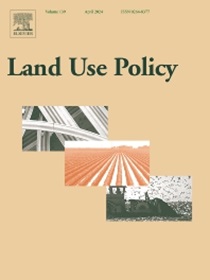Complex relationships between large-scale land acquisitions, deforestation, and land zoning policies in agricultural frontiers
IF 6
1区 社会学
Q1 ENVIRONMENTAL STUDIES
引用次数: 0
Abstract
The study of large-scale land acquisitions (LSLAs) has emerged as a subject of research aimed at understanding the dynamics of land use change. However, studies of the links between LSLAs, deforestation, and zoning policies, important to better understand land use change dynamics, are scarce. The Chaco region in South America is a paradigmatic example of a deforestation hotspot and the rapid expansion of agricultural frontiers to supply commodities for the global economy. Using spatially explicit information on Geographic Information Systems and time lagged cross-correlation functions, we analyzed links between LSLAs, deforestation, and zoning policies in a portion of the Chaco region in Salta, Argentina, in the period 1998–2021. We show that the links between LSLAs and deforestation are more complex than initially thought. LSLAs are often one of the drivers of deforestation, but we also found that several acquisitions target already deforested land. Investor behavior is also complex. Local or regional investors seem more interested in forested land than international ones, who are more risk-averse and seek shorter term profits. Some local companies specialize in buying land to build infrastructure and sell it back to another local or international company that will ultimately oversee the production stages. We also show in this paper that restrictions imposed by the Forest Law encouraged medium- to large-scale companies to acquire land that was already in production or with government-approved land use plans, aiming to reduce uncertainty and time-consuming bureaucratic processes triggered by the new law. The results of this study could help understand investor behavior and land governance processes in this region. The Land Matrix Initiative database, together with statistical analysis and satellite images showing land use cover and land use change processes, offers valuable information to study dynamics and patterns of land use change at several geographic scales.
农业前沿地区大规模征地、森林砍伐和土地分区政策之间的复杂关系
大规模土地征用研究已成为旨在了解土地利用变化动态的一个研究课题。然而,对lsla、森林砍伐和分区政策之间联系的研究对更好地了解土地利用变化动态很重要,但却很少。南美洲的查科地区是森林砍伐热点地区和农业边界迅速扩大以为全球经济提供商品的典型例子。利用地理信息系统的空间明确信息和时间滞后的相互关联函数,我们分析了1998-2021年阿根廷萨尔塔查科地区部分地区lsla、森林砍伐和分区政策之间的联系。我们表明,lsla和森林砍伐之间的联系比最初想象的要复杂得多。lsla通常是森林砍伐的驱动因素之一,但我们也发现,一些收购的目标是已经被砍伐的土地。投资者的行为也很复杂。与国际投资者相比,当地或区域投资者似乎对林地更感兴趣,后者更倾向于规避风险,寻求短期利润。一些当地公司专门购买土地建设基础设施,然后将其卖给另一家当地或国际公司,后者将最终监督生产阶段。我们还在本文中表明,《森林法》所施加的限制鼓励大中型公司收购已经在生产的土地或政府批准的土地使用计划,旨在减少新法律引发的不确定性和耗时的官僚程序。研究结果有助于理解该地区的投资者行为和土地治理过程。土地矩阵倡议数据库连同显示土地利用覆盖和土地利用变化过程的统计分析和卫星图像,为研究若干地理尺度上土地利用变化的动态和模式提供了宝贵的资料。
本文章由计算机程序翻译,如有差异,请以英文原文为准。
求助全文
约1分钟内获得全文
求助全文
来源期刊

Land Use Policy
ENVIRONMENTAL STUDIES-
CiteScore
13.70
自引率
8.50%
发文量
553
期刊介绍:
Land Use Policy is an international and interdisciplinary journal concerned with the social, economic, political, legal, physical and planning aspects of urban and rural land use.
Land Use Policy examines issues in geography, agriculture, forestry, irrigation, environmental conservation, housing, urban development and transport in both developed and developing countries through major refereed articles and shorter viewpoint pieces.
 求助内容:
求助内容: 应助结果提醒方式:
应助结果提醒方式:


